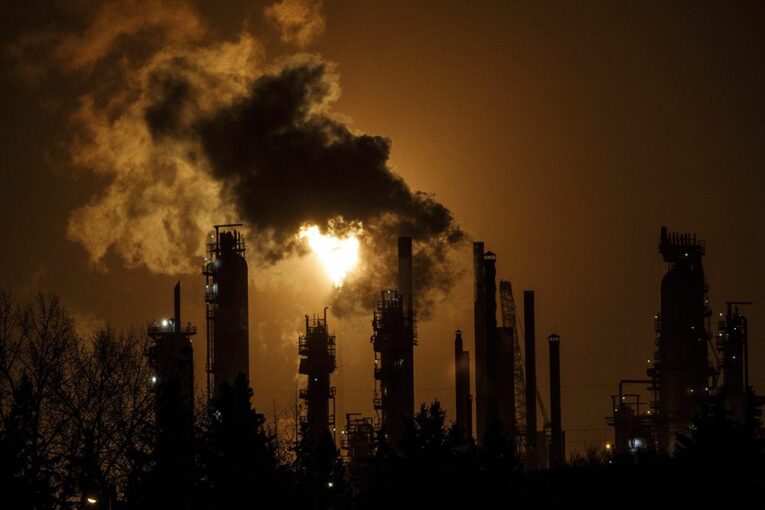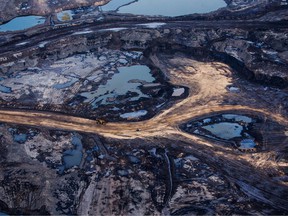
Canadian pipeline companies are investing in renewable power, energy firms are eyeing massive hydrogen projects and oilsands operators have committed to net-zero emissions targets.
These are tangible signs that Alberta companies are embracing green energy policies and transforming for a new future.
Such steps are being taken as Ottawa introduces a new climate blueprint to lower Canadian greenhouse gas emissions, with an aggressive plan rolled out Tuesday that forecasts a 42 per cent reduction by the oil and gas sector by 2030.
No one should underestimate how monumental the challenge will be for the province’s largest industry to hit this goal within eight years and it will require plenty of support.
“It is certainly ambitious,” said Tristan Goodman, president of the Explorers and Producers Association of Canada. “If all options are on the table, at least then we can discuss and see if we can make it there.”
Yet, one juvenile meme from the premier’s Twitter account on Monday undermines the message many Alberta businesses are trying to send out: They are already taking action and have plans to do much more.
Not since the formation of Alberta’s energy war room or the Public Inquiry into Anti-Alberta Energy Campaigns have we seen such a pointless self-inflicted wound.
Vivian Krause, whose research helped inspire the inquiry, called out Kenney over the meme, which shows Chris Rock getting slapped at the Oscars by actor Will Smith, with the words “reality” striking “green energy policies” cast over the image.
“It was needlessly aggressive,” Krause said Tuesday. “That tweet was a kick in the teeth to all of the oil and gas people . . . who work their tail off to be part of the transition.”
Kevin Krausert, CEO of Calgary-based Avatar Innovations, which has launched a clean energy accelerator and training program, pointed out the industry is investing heavily in technology to decarbonize and prepare for the transition.
Yet, many Canadians don’t know it, and a viral meme doesn’t help Alberta make its case.
“This type of hostility is not just counterproductive, it’s out of line with Alberta’s energy industry,” said Krausert.
“It reinforces the worst stereotypes of Alberta at the most critical of times.”
Alberta has attracted billions of dollars in renewable energy in recent years, even as oil and gas production has increased.
Both will be required in the future, and Alberta has plenty to offer.
But how will they fit into Ottawa’s climate objectives?
On Tuesday, the Trudeau government unveiled its new national emissions reduction blueprint, designed to lower overall emissions by 40 to 45 per cent by 2030 (from 2005 levels).
That means big cuts from the oil and gas industry, which makes up 26 per cent of total emissions in the country.
Aside from moving ahead with new clean fuel regulations and increasing the national carbon price to $170 per tonne by 2030, the Trudeau government is also preparing to put a new emissions cap on the sector, beginning in 2025.
The federal document released Tuesday says oilpatch emissions are forecast to drop to 31 per cent below 2005 levels — before many oilsands projects started up — by the end of this decade.
Consultations on the cap will take place this year.
“We’re laying down a clear, reasonable contribution for the sector to make,” Prime Minister Justin Trudeau said in Vancouver.
“With record profits, this is the moment for the oil and gas sector to invest in the sustainable future.”
Yet, there were few details on what targeted actions will deliver specific reductions from the oilpatch.
Alberta Environment Minister Jason Nixon pointed out economic modelling detailed in the report indicates oilsands production could fall by 10.6 per cent by 2030 from the reference case outlook, while natural gas output could drop by 15.9 per cent.
“That could cost at least around 13,000 jobs in the oil and gas industry in this province alone,” Nixon said in an interview.
“We need to work together on emissions reductions, but we can’t do it in such a way that is catastrophic to both the provincial and the Canadian economy.”
NDP Leader Rachel Notley called the federal target a “fantasy” and said a real plan is needed to protect Alberta workers.
The country’s transportation sector, with roughly the same amount of emissions as the oilpatch, is only expected to see an 11 per cent reduction by 2030, something she said was manifestly unfair.

The federal report states the intention of the emissions cap on Canada’s oil and gas industry is not to cause production decreases “that aren’t driven by a drop in global demand” — but how will that be guaranteed?
It also notes an investment tax credit for carbon capture and storage projects will help support federal decarbonization efforts.
These are critical issues for the industry and the thousands of people it employs across Canada.
The Oilsands Pathways to Net Zero Alliance, representing the largest oilsands operators in the province, said the federal plan is a challenge for all Canadian industries and will require collaboration.
“With the 2030 milestone only eight years away, we need realistic and achievable goals, to maintain and attract needed investment in Canadian energy and technologies to reduce emissions,” alliance interim director Kendall Dilling in a statement.
Will that happen?
Tamarack Valley Energy CEO Brian Schmidt said his company has already reduced its emissions per barrel — or emissions intensity — by almost 40 per cent over the past few years, and it’s dropping the overall total while modestly increasing output.
While the Canadian industry continues to make progress on emissions intensity, requiring an absolute cut of more than 40 per cent by 2030 will likely sideline larger projects in the future, such as new liquefied natural gas developments, he cautioned.
“It is a death knell for big projects,” said Schmidt.
“I think we are far better served to try and find solutions to produce the cleanest product we can.”
That is sound advice.
As a major oil and gas producer, Canada needs to make significant emissions reductions, entice investments, develop new technologies and protect jobs. It’s a daunting task.
More planning, progress and details are required — and fewer divisive memes.
Chris Varcoe is a Calgary Herald columnist.
You can read more of the news on source
